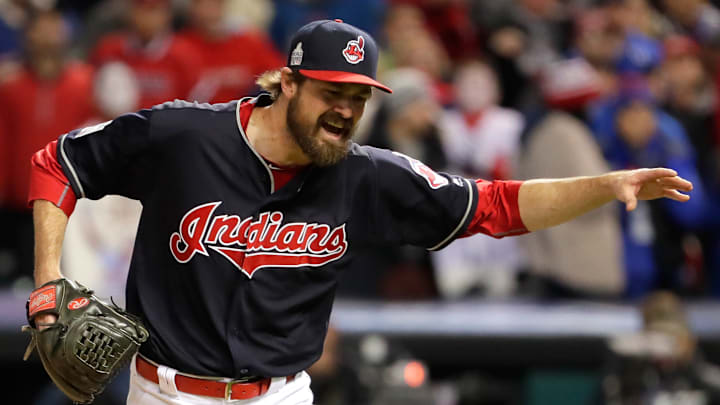For seven years now, the 2016 Yankees have been used as a prime example of effective deadline selling, with New York's mediocrity giving Brian Cashman a rare opportunity to refill the farm system and spark a potential dynasty.
Considering the Yankees went immediately back to the ALCS the very next season and entered a contention window that's lasted from 2017 to present (or did it end in 2019?), it's been very simple to label the firesale a clear win. In reality, though, many of the parts that spurred on that 2017 run were already in place (or were added, as fortifiers, at the '17 deadline in a massive deal with the Chicago White Sox). And yes, the Yankees reached Game 7 of the ALCS against a fire-breathing and notorious Astros team, but having lefty reliever Andrew Miller on the roster actually would've helped them tremendously in that series.
It's the Red Sox theorem. Isn't it impressive that Boston went to the 2021 ALCS without Mookie Betts? Yeah. But they would've been better off if they'd had Mookie Betts when they got there.
Instead of using the 2016 trade deadline to win games, Cashman mostly won headlines, restocking his farm with big-named prospects who the Yankees were unable to develop. A few times, those failures were circumvented by trading said players elsewhere as devalued assets, acquiring more key players who'd eventually come up small.
You want the harsh bottom line? Sending two teams to the World Series in 2016 while never reaching one yourself in the resulting era shouldn't be viewed as a victory.
As the Yankees lose 2/3 to a bad Rockies team, I'm reminded of Brian Cashman saying "a true playoff contender, you know, not a playoff pretender, wouldn't do that" after the Yankees got swept by the last place Rays right before the 2016 deadline, and decided to sell.
— River Ave. Blues (@RiverAveBlues) July 16, 2023
Who did the New York Yankees trade at 2016 trade deadline sale, and who did they receive?
When the dust settled on the '16 deadline, the Yankees chose to sell their two best relievers, Aroldis Chapman and Andrew Miller, as well as veteran and 2016 All-Star Carlos Beltrán. Beltrán and Chapman were both on expiring deals; those were easy calls. Miller, on the other hand, was under contract through 2018; he'd been the Yankees' biggest offseason splash and most astounding beard shaver a year and a half prior.
Somehow, Cashman spun Chapman into the most impressive package of all, calling the Cubs' bluff as they peaked in the Theo Epstein era. Gleyber Torres was one of baseball's best prospects at the time, and was the Yankees' No. 1 choice over Ian Happ, Albert Almora, Willson Contreras and Co. After a lengthy back-and-forth in the rumor mill, they secured him along with Billy McKinney (also a top name), familiar face Adam Warren and Rashad Crawford, a speedy lottery ticket. It's hard to argue they could've done better, even though Torres has matured from "future MVP/current All-Star" to "maddening, talented hitter who banged into his own ceiling during the Juiced Ball Era." Like most Yankees, he's gotten worse in recent years.
The other two trades? Beltrán netted them Dillon Tate (former No. 3 overall pick), as well as pitching prospects Erik Swanson and Nick Green. Tate was considered a coup, and ... sure, but he was eventually dealt to Baltimore in a package for Zack Britton. Britton posted a 2.88 ERA down the stretch for the 2018 Yankees (4.08 FIP) as they valiantly attempted to chase the 2018 Red Sox (technically). He was re-signed at a hefty sum, dominated in 2019 while continuing to beat back the FIP regression allegations (1.91 ERA/3.74 FIP), pitched well in 2020 (a fake season), and unraveled the next two years.
Swanson, too, was traded, alongside Justus Sheffield, a key piece from the Miller trade, in exchange for James Paxton entering the 2019 season. Paxton was his typical self with the Yankees -- sometimes dominant, sometimes baffling, oft-injured, and always memorable for his clutch start in Game 5 of the 2019 ALCS (never mind that his poor start in Game 2 helped send the series off-kilter). Sheffield hasn't worked out at any stop; Swanson is 29 years old and among the best relievers in the Blue Jays' bullpen.
Ah, the Miller trade. The toughest call of them all. Sending an All-Star reliever to an AL rival in the throes of a playoff push netted the Yankees Sheffield and Clint Frazier, two top-100 prospects, as well as relievers JP Feyereisen and Ben Heller. Heller has resurfaced with the Rays and Braves to pitch quite well in 2023, following multiple elbow complications. Feyereisen was also a great burn-and-churn Rays reliever, as well as a member of the Willy Adames swap. Sheffield became Paxton. Frazier bore the most direct fruits for the Yankees, though sadly concussions derailed his progress on multiple occasions.
Ultimately, the modern Yankees excelled in 2017 thanks to Aaron Judge's emergence, Aroldis Chapman's return, Chad Green's arrival, and Gary Sánchez's sophomore powerhouse season. They missed Miller. They got ejected from the playoffs by Beltrán's new team. Perhaps he still would've joined the Astros in free agency if the Yankees had never traded him, but it's fitting that the man who introduced Houston to the wonders of technology blocked New York's recent peak after they supposedly maximized his value at the deadline. Hope Baseball America applauding the Tate maneuver was worth it.
Even the 2016 fire sale, like so many other recent Yankees moves, was better in process than in reality, where Chicago, Cleveland and Houston profited from the Yanks' pursuits more than Cashman himself did. Maybe the process isn't so great after all.
